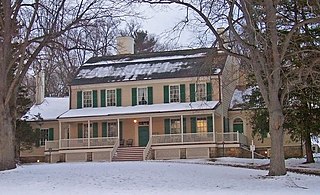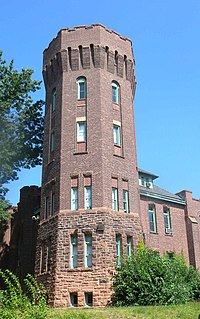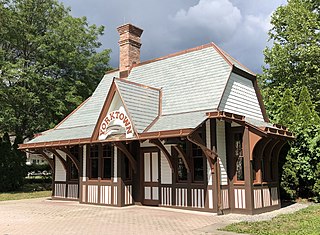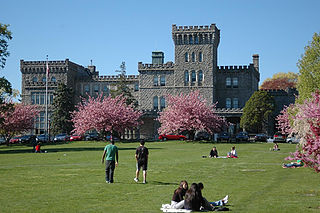
The Claremont Riding Academy, originally Claremont Stables, 175 West 89th Street, between Columbus and Amsterdam Avenues on Manhattan's Upper West Side, was designed by Frank A. Rooke and built in 1892. Closed in 2007, Claremont was the oldest continuously operated equestrian stable in New York City and the last public stable in Manhattan. The building was listed on the National Register of Historic Places in 1980 and designated a New York City Landmark in 1990. Since 2010, it has belonged to the Stephen Gaynor School.

The John Jay Homestead State Historic Site is located at 400 Jay Street in Katonah, New York. The site preserves the 1787 home of statesman John Jay (1745–1829), one of the three authors of The Federalist Papers and the first Chief Justice of the United States. The property was designated a National Historic Landmark in 1981 for its association with Jay. The house is open year-round for tours.

New York State Armory , also known as "The Arsenal," is a historic National Guard armory building located at Ogdensburg in St. Lawrence County, New York. It is a rectangular, two story structure built of ransom ashlar block with central pavilions projecting on its north and south elevations. The main facade features a central pavilion with a tower rising above the roofline and terminating in a corbeled and crenellated parapet. It was designed by noted Syracuse architect Horatio Nelson White.

The Flushing Armory is a historic National Guard armory building located in Flushing, Queens. New York City. It is a brick and stone castle-like structure built in 1905–1906, designed to be reminiscent of medieval military structures in Europe. It was designed by state architect George L. Heins.

The Pioneer Building is a late nineteenth-century commercial/office structure located on Lawton Street in the Downtown business district of the City of New Rochelle in Westchester County, New York. The building is a good example of Neo-Italian Renaissance commercial style and represents an important aspect in the late nineteenth and early twentieth century history of New Rochelle. John New & Son, the New Rochelle builder responsible for its construction, is credited with its design. The Pioneer Building is considered significant, partly because other historic buildings that once surrounded it have been demolished and replaced by newer construction. It was added to the Westchester County Inventory of Historic Places on January 5, 1988, to the New York State Register of Historic Places on November 23, 1983, and to the National Register of Historic Places on December 29, 1983.

Yorktown Heights station is a former railroad station on the Putnam Line in Yorktown Heights, New York, United States. It is a wooden building located on Commerce Street at the intersection of Underhill Avenue in Railroad Park.

The W New York Union Square is a 270-room, 21-story boutique hotel operated by W Hotels at the northeast corner of Park Avenue South and 17th Street, across from Union Square in Manhattan, New York. Originally known as the Germania Life Insurance Company Building, it was designed by Albert D'Oench and Joseph W. Yost and built in 1911 in the Beaux-Arts style.

Rehoboth is a historic former barn located on Aldridge Road in Chappaqua, New York, United States. It is a concrete structure that has been renovated into a house with some Gothic Revival decorative elements. In 1979 it was listed on the National Register of Historic Places.

The Caleb Hyatt House is a historic house located at 937 White Plains Post Road in Scarsdale, Westchester County, New York.

Peoples National Bank and Trust Company Building is a historic bank building located at White Plains, Westchester County, New York. It was built in 1929 and is a nine-story commercial building in the Classical Revival style. It has an L-shaped plan and features highly finished limestone and brick materials and terra cotta ornament at the street level. Above the two-story base, the building remaining stories are built of brick with limestone trim.

White Plains Rural Cemetery is a historic cemetery located in the city of White Plains, Westchester County, New York. The cemetery was organized in 1854 and designed in 1855. It contains miles of narrow, paved roads, none of which is in a straight line. The roads create circular and lozenge-shaped areas for burials. Also on the property is a former church, now cemetery office. It was built in 1797, and is a 2 1⁄2-story, five-by-three-bay frame building with a high-pitched gable roof. It was modified for office use in 1881.

Bolton Priory is a historic home built in 1838 for the Reverend Robert Bolton and his family, in the Village of Pelham Manor in Westchester County, New York. The home stands upon a wooded tract of land overlooking Pelham Bay; the once large estate surrounding it has now diminished to 3.7 acres. Influenced by the Romantic Movement in England, Bolton chose to design the house in the Romantic idiom. The building was designed to appear as if it had been constructed over a period of time; stone was used in one section and brick in another, to give the impression of various additions.

The White Plains Armory is a historic building in White Plains, New York, in Westchester County.

Reid Hall, also known as "The Castle," is a historic academic building located on the campus of Manhattanville College at Purchase, Westchester County, New York, United States.

The Beecher-McFadden Estate is a historic estate located on East Main Street in Peekskill, Westchester County, New York.

Rogues' Harbor Inn, also known as the Elm Grove Inn and Central Exchange Hotel, is a historic inn and tavern located at Lansing in Tompkins County, New York. It was built between 1830 and 1842 by Major General Daniel D. Minier, and is a three-story brick building in the Greek Revival style. It is a 40-foot-deep by 80-foot-wide rectangular building on a stucco-coated fieldstone foundation with a gable roof. It features a full-width porch with a roof supported by turned posts. The author Grace Miller White (1868–1957) used it as the inspiration for the setting for her novel Judy of Rogues Harbor. It has continued to operate as a bed and breakfast country inn and restaurant.

Woman's Club of White Plains, originally known as the Thomas H. Kerr residence, is a historic clubhouse located at White Plains, Westchester County, New York. It was built in 1910 as a residence and enlarged in 1932, after being acquired as a clubhouse for the Contemporary Club. McKim, Mead and (Sanford) White were the architects of this property, which originally had 41 acres, including a small farm and extensive orchards. It is a two-story, stuccoed, poured concrete building in the Italian Renaissance Revival style. It features a broad hipped roof, deep overhanging eaves, and prominent brick chimneys. It has large glass-enclosed porches at each end of the house.

Presbyterian Rest for Convalescents, also known as the Y.W.C.A. of White Plains and Central Westchester, is a historic convalescent home located at White Plains, Westchester County, New York. It was built in 1913, and is a 3 1/2-story, "H"-shaped building in the Tudor Revival style. The two lower stories are in brick and the upper stories in half-timbering and stucco. It has a tiled gable roof with dormer windows. The section connecting the two wings includes the main entrance, which features stone facing and Tudor arches. The connected Acheson Wallace Hall was built in 1972. The building housed a convalescent home until 1967, after which it was acquired by the Y.W.C.A. and operated as a residence for women.

Frank Aydelott Rooke, known professionally as Frank A. Rooke, was a New York architect who designed the historic Claremont Riding Academy and numerous other structures of significance that are either in National Historic Districts or listed on the National Register of Historic Places in the tri-state area.

150 Nassau Street, also known as the Park Place Tower and the American Tract Society Building, is a 23-story, 291-foot (89 m) building in the Financial District of Lower Manhattan in New York City. It is located at the southeast corner of Spruce Street and Nassau Street, next to 8 Spruce Street, the former New York Times Building, and New York City Hall.
























